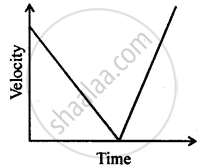Advertisements
Advertisements
Question
An object starting from rest travels 20 m in the first 2 s and 160 m in the next 4 s. What will be the velocity after 7 s from the start?
Solution
For first 2 s motion of object,
u = 0, f = 2 s, s = 20 m
Using s = `"ut" + 1/2 "at"^2`
we got 20 = `0 + 1/2 "a" xx 2^2`
or a = 10 ms−2
Velocity attained by object at the end of 2s
v = u + at
= 0 + 10 × 2
= 20 ms−1
For next 4s, journey of object,
t' = 4s, u' = 20 ms−1, s' = 160 m
∴ s' = `"u'""t'" + 1/2 "a'""t'"^2`
⇒ 160 = `20 xx 4 + 1/2 xx "a'" xx 4^2`
or 8a' = 80 or a' = 10 ms−2
It implies that acceleration is uniform throughout the journey.
∴ velocity after 7s from start, v = u + at
= 0 + 10 × 7
= 70 ms−1
APPEARS IN
RELATED QUESTIONS
When will you say a body is at non-uniform acceleration?
A train starting from a railway station and moving with uniform acceleration attains a speed 40 km h−1 in 10 minutes. Find its acceleration.
Which of the two can be zero under certain conditions : average speed of a moving body or average velocity of a moving body ?
Give one example of a situation in which a body has a certain average speed but its average velocity is zero.
Explain the meaning of the following equation of motion :v = u + at, where symbols have their usual meanings.
A body starting from rest travels with uniform acceleration. If it travels 100 m in 5 s, what is the value of acceleration ?
If a stone and a pencil are dropped simultaneously in vacuum from the top of a tower, then which of the two will reach the ground first? Give reason.
A bicycle initially moving with a velocity 5.0 m s-1 accelerates for 5 s at a rate of 2 m s-2. What will be its final velocity?
How can you find the following?
Acceleration from velocity – time graph.
Can you suggest a real-life example about the motion of a body from the following velocity – time graph?

